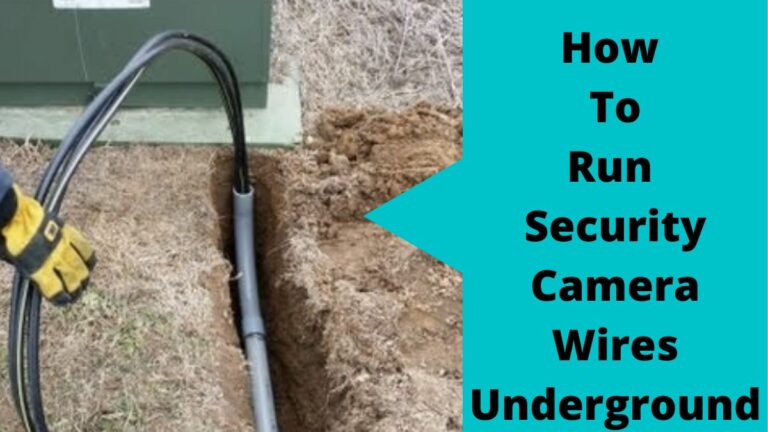Running security camera wires is challenging, especially if you need to run them underground.
So, in this, we’ll dive into the details and steps of how to run security camera wires underground.
If you’re like me, you take your home security seriously then it’s not suitable for you to run security camera wires outside as they will be vulnerable to damage, and cut with a high percentage.
On the other hand, if you decide to run the surveillance system cables inside your home by using walls, and home furniture then you probably will waste a lot of money, and time as you’ll need to pass the wires of the cameras from inside to outside.
After all, we figure out that the best way to protect our security system cables and wires and keep them clean is to run the wires underground.
Recently, I had to run security camera wires underground, it was hard, and not easy. But in the end, I managed to do it with the help of some tools.
So, here in this article, I wanted to share some tips on how to do it, in case anyone else out there is in the same boat.
Can you bury security camera wires? or Can CCTV BNC cable be buried?
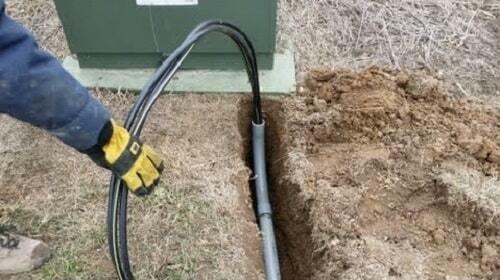
The answer is Yes, you can bury security camera wires underground or behind great walls to protect them. Simply decide your security camera wire routes, use a trenching tool, put a conduit, pass the wires inside it with the help of fish tape, and now you’re done.
For more protection, make sure that the wire is not bent and that there are no loose connections, or wires that are damaged.
What benefits of running security camera wires underground?
There are a lot of hidden benefits to running security cameras in safe spots like underground, or inside the walls. Let’s see
1. More Protection – One of the most obvious benefits of running underground security camera wiring is getting your surveillance system wires protected.
When the wiring is run underground, it becomes much less visible and thus more difficult for potential intruders to find, damage, or cut.
Once you get your security camera wires protected this means that most of your system is also protected as wires represent 50% of any wired security system.
2. Enhanced Durability – Another significant benefit of having underground wiring for your security cameras is enhanced durability.
When buried beneath the ground, the wiring is better protected from harsh weather conditions and physical damage.
This means that you won’t have to worry about your cameras going offline due to damaged wiring, or wires being cut by thieves.
Related: 4 Ways to Get Security Camera Back Online.
3. Keep the beauty – In addition to being more discreet and durable, running security camera wires underground can also remain the beauty of your property.
If you’re concerned about unsightly wires ruining the look of your landscaping, buried wiring will eliminate that problem.
4. Greater Flexibility – Aside from protection, and other benefits. Underground wiring provides greater flexibility when it comes to where you position your security cameras.
Since there are no visible wires to contend with, you can place your cameras exactly where they’ll effective without having to worry about where to run the wiring or the length of the wires.
5. Fewer Interference Issues – One final benefit of running underground security camera wiring is that it can help to reduce interference issues.
As we know, when interference happens it causes a lot of problems for security cameras. Problems such as fuzzy images, CCTV Camera Flickering, no video signal, and others.
So, If you live in an area with a lot of electrical interference, running the wiring underground can help insulate it from this interference and ensure that your camera feed remains clear and uninterrupted.
How to Run Security Camera Wires Underground Like Pro
Before we start at how to run security camera wires underground, you should know that the steps below depend on the security cameras you have, the tools that you’ll use, the ground that you’ll dig in, and also the help from others.
For example, if you run the wires for a standalone security camera it will take a fewer time as you compare to running wires of a large CCTV surveillance system.
Additionally, if you dig in the solid ground it’ll take too much time, and you’ll need more tools to get your running done.
Anyhow, here are the steps, read them carefully and apply what is fit your situation.
Step One: Purchase High-Quality Security Camera Wires
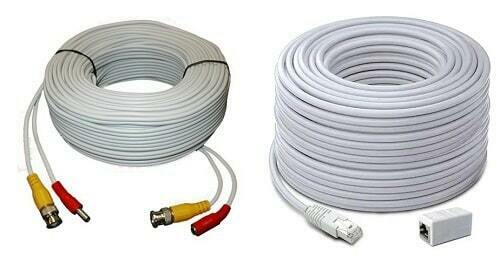
The first step is to purchase high-quality security camera wires. Second, make sure that are wires designed for outdoor use, not indoor.
This is important because common electrical security camera wires are not shielded and will not stand up to the elements like sun, rain, snow, and so on.
In contrast, shielded outdoor security camera wires are specifically designed to withstand all kinds of weather conditions that’s why we recommend using them outside.
Step Two: Pick a Plastic Conduit for Electrical Wires & Cables
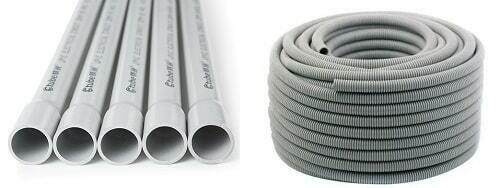
To protect your underground security camera cables, you’ll need to pick a plastic conduit. This will keep them safe from rain, water, moisture, animals, and other potential dangers.
But before you pay any penny, you should choose a conduit that is rated for outdoor use and burial.
Avoid picking cable ducts or electrical wire conduits there are used for other tasks, not for running security camera wires underground.
Moreover, make sure that you get the right length of conduit that will cover all of your wires to avoid splicing and using junction boxes.
Step Three: Dig for Conduits
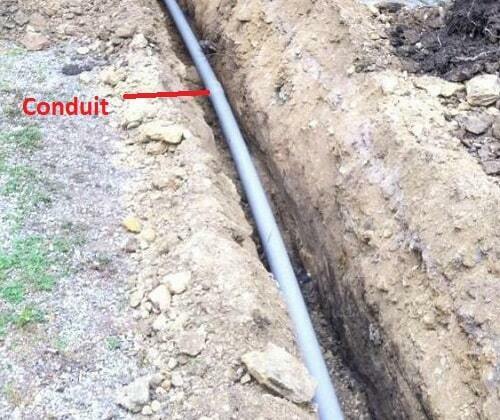
Once you have your wiring, the next step is to dig a path for your monitoring system’s cables.
Drill a path large enough for conduits and cables to fit through, you can measure the conduit diameter and add some millimeters.
What I mean is you don’t want the path of wires to be too large as this could damage your wire connectors, and make them loose.
Also, you don’t have to make the wire path too narrow because that will affect the running cable underground process and make it more difficult.
Anyway, to make the drilling process easier, use a drill bit that is slightly bigger than the diameter of your cables. Doing this will allow you to get some free space to move the cable inside the drilled part.
On the other hand, If you’re running multiple cables, make sure to leave enough space between each one so that they don’t get complicated together while being pulled through the dig.
Once you finish drilling, lay the wire conduit that you purchased in the 2nd step in the path you dug.
After that, go ahead and close the ends of the conduits with masking tape until you start to run the wires.
Step Four: Use Fish Tape to Run Wires of Security Cameras underground
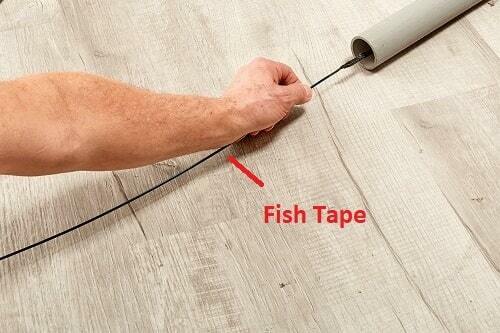
Now it’s time to start running your wires! To do this, you’ll need a device called fish tape (also known as draw wire).
This is a long, flexible piece of metal or nylon used to pull wires through tight spaces—like the ones that used to run electric cables through wall conduits!
Start by feeding one end of the fish tape through one of your conduit sides until it comes out the other side.
Then, attach your cables) to the fish tape using duct tape or electrical tape, after that push the fish tape to make it move toward the second side.
Pro Tip: Make sure that all of your connections are secure before moving on—you don’t want your cables getting stopped on anything while they’re being pulled through!
Step Five: Install the Wire Connectors
The 5th step in how to run security camera wires underground is to install the wire connectors whether RJ45 for ethernet cables or BNC connector for coaxial cables.
These connectors are what will connect your underground cables to your security cameras.
So, be sure to follow the manufacturer’s instructions when installing these, as they can vary depending on the brand.
Generally speaking, though, you’ll want to start by stripping the insulation off of the end of each cable.
Next, untwist each of the individual wires around the main copper cable in case of coaxial cable or remove the outer insulation part if it’s a network ethernet cable.
Finally, bring the connector, and connect the copper wires to it, tie the screws on the wires, then put the cover and tighten it down.
See Also: How To Connect Cat6 Cable to CCTV Security Camera
Step Six: Test the Cable Connections
Once you have installed the wire connectors, it’s time to test the cable connections. The best way to do this is with a multimeter, or by using a cable tester device.
First, set the multimeter to “ohms” mode. Next, touch one lead of the multimeter to each of the exposed terminals on the wire connector.
If the multimeter displays a reading other than zero, then you have a good connection. If not, check your work and make sure that all of the individual wires are properly connected to their terminals.
In case you purchase a cable tester device, then you should test the cable connections before your run them underground.
First, install the connectors on both sides of the cable.
Second, Turn on the device, and make sure the LEDs are on.
Third, Insert both side connectors on the device ports.
Forth, The LEDs of the port will emit light if the connections are correct. If not, then you should check the connections again.
However, if you are sure that you install the connectors the right way, then you can skip this step, or you can purchase from the beginning a security camera cable connected to its connectors.
You can watch the following video to know more about how to run security camera wires underground.
Source: StarPuss
Conclusion
Running underground security camera cables is a great way to keep your cameras hidden from view while still providing them with the power they need to operate.
By following the steps outlined in this article, you can ensure that your cables will be properly protected from the elements and any potential damage.
